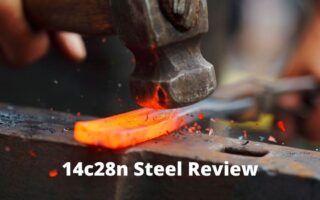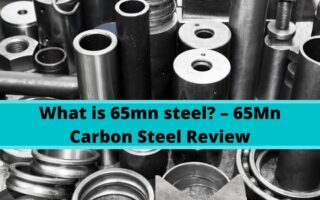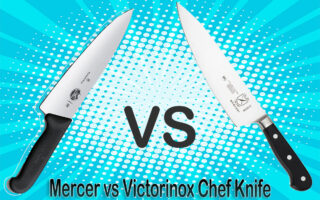Maxamet Steel Review
Is Maxamet Steel Good for Knives? Are you looking for a knife that will meet all your needs? Maybe a kitchen knife/ camping knife or EDC? Then first you have to check out the steel that is used to make the knife. Then you can figure out if it is for you. If you are a knife user or knife maker you have probably come across the name Maxamet Steel.
So I was looking for an entry-budget knife for good edge retention and this steel caught my attention. When you look for a knife with edge retention, some will definitely suggest this Steel. As you are here in this blog post, that means you wish to know more. I had my doubts first when I was introduced to this steel. I have done my research well about this steel and answered the most useful questions you may have about this knife.
So here is an in-depth Maxamet Steel Review. So let’s dive in! In the world of strong steels for multiple uses such as knives and blades, Maxamet steel has emerged in current years among the very top of well-performing alloys – especially for its edge retention.
This steel is created from a high-tech melding of special and unique ingredients which enhanced the strength and performance of knife blades and other applications of high-quality steel. This American-made steel alloy caught the attention of us knife users by producing long-lasting and precise knife blades that can be used for a great range of applications.
Its edge retention is considered top in the industry right now! Maxamet is also known for its strength and wear resistance and these qualities are all we knife fanatics look for in a knife blade.
What is Maxamet steel?
Maxamet is non-stainless powder steel invented and produced by Carpenter Technology Corporation (NYSE: CRS) based in Philadelphia which is considered a leading supplier of high-performance steel globally. This specialty alloy is one of the top choices for the best edge retention available.
This steel is a belt for knives with a different chemical composition, it has a high volume of Tungsten and high in carbon which is revolutionary in the knife industry. The development and introduction in recent years of Micro-Melt Maxamet, this steel is extremely hard as the properties, produced through the powder metallurgy process.
Maxamet is already popular among the top super steels available today around the world. Super steel, a term dating back 40 years now, today we refer super steel to high wear-resistant steels with great edge retention like Maxamet. Maxamet already ranks high among luxury-level super steels.
Maxamet Chemical Composition
Maxamet has a very unique chemical composition in the industry. The main components of this high-speed tool steel deliver a wide range of benefits.
•13.00% Tungsten: Adds hardness and cutting efficiency to its alloying elements among other positives. The use of this material is said to be revolutionary to the industry. This is what makes the knife stand.
•10.00% Cobalt: Enhances wear and corrosion resistance, and strength in high temperatures.
•6.00% Vanadium: For a significant increase in strength of the steel. Compared to other steels this percentage is considered quite high by industry standards.
•4.75% Chromium: For increasing tensile strength, Edge retention and also enhances corrosion resistance and wear resistance.
•2.15% Carbon: To boost corrosion and wear build resistance.
•0.70% Sulfur: Applied to boost machinability for the Micro-Meld Maxamet steel and decreases strength thus brings a balance to the whole mixture.
•0.30% Manganese: For enhancing hardness and brittleness. The higher the hardness level, the more a blade can take and hold a better edge.
•0.25% Silicon: To further bolster its level of strength like Manganese
•Nominal amount of Iron is sprinkled into the mixture to further increasing the strength and balance out the whole mixture.
So it appears, The Carpenter Technology has hit upon a perfect blend. The use of rather unusually high volumes of Tungsten, Cobalt, and Vanadium presents top-level performances in all the areas knife owners prefer (edge protection, strength, wear resistance, and hardness). Knife reviewers are amazed at the quality of this steel. Users rave reviews for edge protection, some going as far as saying its knife edges retain sharpness seemingly forever.
How strong is Maxamet steel? (Rockwell hardness)
To know about a knife and its potential Rockwell hardness is a key factor. Every steel has its own specific HRC, from 54 HRC to 64 HRC. Rockwell Hardness 64 at room temperature makes high-speed steel. Most of the time we assume the higher the HRC the stronger the knife is. But steel achieved high hardness by high carbon content. This is incorrect given that hardness grows at the cost of toughness.
When the steel is harder it loses its toughness and vice versa. For instance, A kitchen knife and a hunting knife have different purposes. For a kitchen knife, we prefer high hardness with an HRC of 62 or more for greater edge retention, and for a hunting knife, a camper would prefer something that has a lower HRC so that can be easily sharpened.
According to Cartech Maxamet steel is often found with an HRC rating of 67-68 HRC. Some even reach 70 HRC. Which depends greatly on the heat treatment and other factors used. 70 HRC is about the highest rating you can normally get for your knife.
The steel is actually very hard-you can say super hard. It’s one of the hardest steels available for commercial knives. And probably this the reason that explains its topnotch edge retention and wears resistance. The huge amount of tungsten, carbon, vanadium makes it high-speed steel and reaches 70 Rockwell C.
Maxamet Steel Properties
According to steel- and knife-industry watchers and experts, key beneficial properties for Maxamet steel include:
Superior edge Retention: This steel knife has the best edge retention due to the high amount of Tungsten, Vanadium, and Carbon. A high maximum Rockwell hardness of 70HRC makes it the best in the industry in this category
High wear resistance: Due to the generous amount of Tungsten, Vanadium, and Carbon, the Maxamet offers a high wear resistance.
Low Corrosion Resistance: Corrosion resistance always depends on the amount of Chromium in the steel. This Steel has a low amount of Chromium (4% compared to 12-14% in other stainless steel), which makes it not great steel in terms of corrosion resistance.
Machinability: This steel is great in this area thanks to the presence of Sulfur (Interesting fact- The Company offers an improved “Sulfur” Maxamet for machinability with 0.23% of sulfur if someone is interested to use Maxamet for high-speed machine operation.)
Sharpness: Given that Maxamet is very hard steel, sharpening this steel is a hard task. If you are a knifemaker, grinding the steel won’t be an easy task either.
Decent Toughness: As we all know the harder the steel, the easier it breaks. Although Maxamet steel is tough enough to handle some beating, damaging work, compared to other steels in this category it has low toughness.
Is Maxamet Steel Good for knives?
The obvious answer is yes, it’s really good knife steel. Maxamet steel has a solid reputation for being very good for knives. It is in fact considered above average. If you are looking for a knife with excellent edge retention especially, Maxamet should be your first choice.
This American-made high-speed alloy has performed so well under multiple conditions; from cooking to cutting carpet or shaping wood this knife blade is the best for all activities. It is prey good for knives. One thing to keep in mind while using this knife is, it is not stainless steel. It only has 4% of chromium in it. Thus the knife is not great concerning corrosion resistance.
So if you have to use the knife in a humid environment you have to take good care of your knife. Other than that it has strong and wear-resistant. So it’s perfect for the kitchen, on-the-job site, or for other cutting or chopping needs. It’s the great steel of an EDC knife. Users very much appreciate its ability to hold edges without an unusual amount of maintenance.
Best Maxamet Knives
One of the best Maxamet knives you can get is Spyderco Native 5 which is an improved classic model of Spyderco’s product line. The NATIVE 5 is a beast that combines strength, superior cutting performance, extraordinary edge retention, and point utility. This Native 5 handle is fabricated with Fiberglass Reinforced Nylon and comes with a back lock mechanism, creating a lightweight yet high-strength knife handle. It also a four-position pocket clip, which makes it very comfortable and efficient. If you’re looking for an EDC knife with a Maxamet Steel, the NATIVE 5 is your choice. You can get a good amount of control and precision as it has a plain Edge grind which is known for creating a smooth and exact cut. Native 5 is high quality and premium design knife and it has become my personal favorite in no time.
Will Maxamet Steel Rust?
Yes, Maxamet steel can rust, since it is not stainless steel (It has only 4% of Chromium in it). But knife fanatics think the amount of strength, edge retention, and wear resistance of this steel can trade off for keeping its surface consistently dry and clean. If you live in humid or rain-heavy locations and use the knife for fishing or boating, make sure to take care of it to keep it in shape.
Maxamet Steel Equivalent
The Maxamet steel is known as a “Super Steel”. It is a high-end steel alloy with a unique chemical composition. Let’s look at how Micro Meld- Maxamet steel compares with other types of steel, in the areas of toughness, edge retention, corrosion resistance, and sharpness. I use a scale or note from 1 to 10 with 10 being the best possible grade.
MAXAMET Vs S110V
| Attributes | MAXAMET | S110V |
| Toughness | 2/10 | 2/10 |
| Easy sharpening | 2/10 | 5/10 |
| Edge Retention
| 10/10 | 8/10 |
| Corrosion Resistance | 3/10 | 7/10 |
Maxamet and S110V are both high-performance steels commonly used in the production of knives. They are known for their exceptional edge retention and toughness. However, there are some differences between the two steels that are worth noting.
- Composition:
- Maxamet: Maxamet is a high-speed tool steel developed by Carpenter Technology Corporation. It contains high amounts of carbon (2.15%), chromium (4.75%), vanadium (6.0%), tungsten (13.0%), and cobalt (10.0%). It also has small amounts of molybdenum and nickel.
- S110V: S110V is a powdered metallurgy stainless steel manufactured by Crucible Industries. It is a high vanadium stainless steel, containing carbon (2.8%), chromium (15.25%), molybdenum (2.75%), vanadium (9.0%), niobium (0.3%), and cobalt (3.5%).
- Edge Retention: Both Maxamet and S110V are known for their exceptional edge retention. However, Maxamet is often considered to have slightly better edge retention compared to S110V. The high carbon and tungsten content in Maxamet contribute to its outstanding hardness and ability to hold an edge for extended periods.
- Toughness: While both steels are known for their high hardness, S110V generally exhibits better toughness than Maxamet. The addition of niobium in S110V enhances its toughness, making it less prone to chipping or breaking under heavy use.
- Corrosion Resistance: S110V is a stainless steel, meaning it has a higher resistance to corrosion compared to Maxamet. Maxamet, on the other hand, is not a stainless steel and is more susceptible to corrosion if not properly maintained.
- Ease of Sharpening: Both Maxamet and S110V are challenging to sharpen due to their high hardness. However, Maxamet is considered more difficult to sharpen than S110V due to its extreme hardness and wear resistance. It requires the use of high-quality sharpening tools and techniques.
Ultimately, the choice between Maxamet and S110V depends on personal preferences and specific use cases. If you prioritize edge retention and are willing to put in the effort to maintain the blade, Maxamet may be a suitable choice. On the other hand, if you value a balance between edge retention and toughness, along with better corrosion resistance, S110V could be a better option.
MAXAMET VS M390
| Attributes | MAXAMET | M390 |
| Toughness | 2/10 | 6/10 |
| Easy sharpening | 2/10 | 5/10 |
| Edge Retention
| 10/10 | 8/10 |
| Corrosion Resistance | 3/10 | 8/10 |
Once again, Maxamet fares well in edge retention in the cost of other measurements such as toughness, corrosion resistance, and difficulty in sharpening. M390 offers better toughness, corrosion resistance and it’s a bit easier to sharpen.
MAXAMET VS CRUWEAR
| Attributes | MAXAMET | CRUWEAR |
| Toughness | 2/10 | 4/10 |
| Easy sharpening | 2/10 | 5/10 |
| Edge Retention
| 10/10 | 7/10 |
| Corrosion Resistance | 3/10 | 5/10 |
Maxamet and Cruwear are both high-performance tool steels known for their excellent toughness and edge retention. While they share some similarities, there are also notable differences between the two.
- Composition: Maxamet is a powder metallurgy steel developed by Carpenter Technology Corporation. It contains a high percentage of tungsten (13%), along with other elements like carbon, vanadium, chromium, and molybdenum. On the other hand, Cruwear is a tool steel produced by Crucible Industries and consists of iron, carbon, chromium, vanadium, tungsten, and molybdenum.
- Edge Retention: Maxamet is renowned for its exceptional edge retention, often considered one of the best among tool steels. It can maintain a sharp edge for extended periods of heavy use, making it suitable for applications that demand long-lasting cutting performance. Cruwear also offers good edge retention, although it may not match Maxamet in this aspect.
- Toughness: Both Maxamet and Cruwear excel in terms of toughness, meaning they can resist chipping and breakage well, even under demanding conditions. They are designed to withstand heavy use and provide durability.
- Corrosion Resistance: Cruwear offers better corrosion resistance compared to Maxamet. While Cruwear is not considered stainless steel, it contains enough chromium to provide some protection against corrosion. Maxamet, however, is more prone to corrosion and requires proper care and maintenance to prevent rust.
- Wear Resistance: Maxamet exhibits superior wear resistance due to its high carbide content, particularly tungsten carbides. It excels in abrasive cutting applications and is often favored for heavy-duty tasks. Cruwear also offers good wear resistance but may not match Maxamet’s performance in this regard.
- Sharpening Difficulty: Maxamet is known to be challenging to sharpen. Its extremely high hardness and wear resistance make it more time-consuming to restore a keen edge. Cruwear, while still relatively tough, is generally easier to sharpen compared to Maxamet.
When choosing between Maxamet and Cruwear, it’s important to consider the specific requirements of your application. If edge retention and wear resistance are crucial, Maxamet might be the better choice. However, if you prioritize corrosion resistance and easier sharpening, Cruwear could be a more suitable option.
MAXAMET VS S30V
| Attributes | MAXAMET | S30V |
| Toughness | 2/10 | 3/10 |
| Easy sharpening | 2/10 | 5/10 |
| Edge Retention
| 10/10 | 2/10 |
| Corrosion Resistance | 3/10 | 5/10 |
This comparison shows the largest gap in edge retention. In all ways, MAXAMET is ahead of the game than S30V. Users complained a lot about how quickly the S30V blade became blunt for general cutting on typical items.
MAXAMET VS M4
| Attributes | MAXAMET | M4 |
| Toughness | 2/10 | 3/10 |
| Easy sharpening | 2/10 | 4/10 |
| Edge Retention
| 10/10 | 7/10 |
| Corrosion Resistance | 3/10 | 8/10 |
Properties for the M4 are fairly most-balanced around, M4 is very well for its toughness according to user observations. The comparison might differ from the priority on the elements. If a user prioritizes corrosion resistance over other elements, M4 will be a better option since Maxamet is vulnerable to rust if not cared for properly. M4 also provides good edge retention which is admirable.
MAXAMET VS S90V
| Attributes | MAXAMET | S90V |
| Toughness | 2/10 | 6/10 |
| Easy sharpening | 2/10 | 5/10 |
| Edge Retention
| 10/10 | 6/10 |
| Corrosion Resistance | 3/10 | 6/10 |
The S90V shows a perfect balance in all the elements compared to the Maxamet alloy.
MAXAMET VS Rex 45
| Attributes | MAXAMET | Rex 45 |
| Toughness | 2/10 | 7/10 |
| Easy sharpening | 2/10 | 5/10 |
| Edge Retention
| 10/10 | 7/10 |
| Corrosion Resistance | 3/10 | 4/10 |
Rex 45 steel scores very well against Cruwear. Again, Maxamet goes down while sacrificing elsewhere for edge retention
Final Word
If you’re interested in the Maxamet steel for your knife, and still have doubts, I want to assure you that it is really excellent steel. This alloy steel scores fairly well when compared with most similar options available. This alloy has been called a “sophisticated” brew of elements cause of its advanced unique chemical composition.
If you are on the lookout for a supremely high-quality knife, the micro-meld Maxamet steel is right up your alley. Depending on your preference and usage, it has extreme edge retention and excellent wear resistance capability but is low on corrosion resistance.
Also in a similar price range, this steel is more luxurious. If you’re an EDC user and you want a knife for tactical usage such as opening boxes or canes or whatever your bare hands can’t handle, Maxamet will be the right choice for you without any doubts.
But, if you’re a Diver, Hunter and you like to use your knife in humid places, I wouldn’t recommend the Maxamet for you. You can go for S110V instead if you are looking for premium steel with greater corrosion resistance. Interestingly, recent reviews by actual Maxamet users indicate the sharpening blades made of the alloy are not as difficult as previously reported.
It will be interesting to see if the company overcomes the shortcomings and possibly improve the cocktail materials involved with the Maxamet line process.
Also, if you’ve used this steel knife and liked it, leave a comment for people who are willing to buy it. It would be helpful for them. And if you have another opinion about it, feel free to comment on what you think.
Happy slitting!
![Maxamet Steel Review [YEAR] 1 Taras Kulakov](https://knivesngear.com/wp-content/uploads/2021/06/Taras-Kulakov.jpg)
Hi, my name is Taras Kulakov and I’m a knife enthusiast. I have been collecting knives for over 30 years and I’ve owned literally thousands of different models over that time. My goal with this site is to share some of what I’ve learned about knives. You can find more info about Taras Kulakov here.
Last update on 2023-03-13 / Affiliate links / Images from Amazon Product Advertising API

![Is 8Cr13MoV Good Knife Steel? [Composition] 2 What is 8Cr13MoV?](https://knivesngear.com/wp-content/uploads/2021/03/8Cr13MoV-320x200.jpg)


